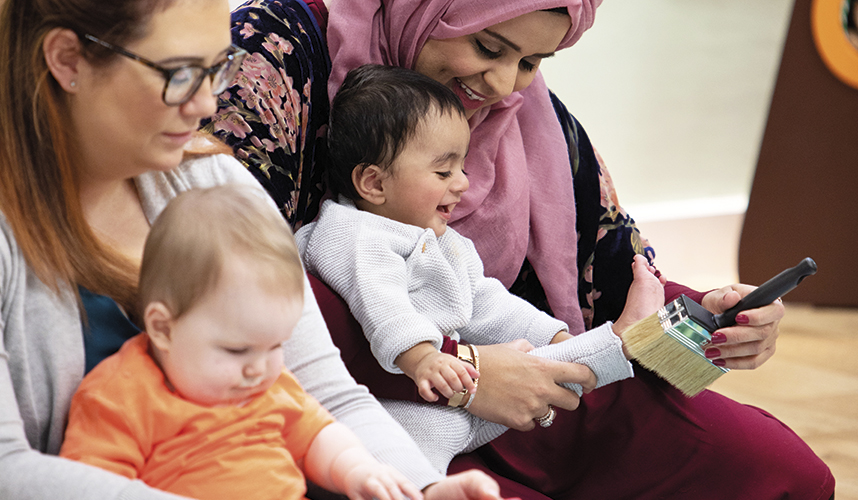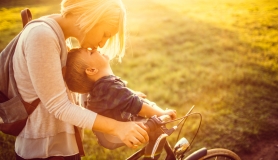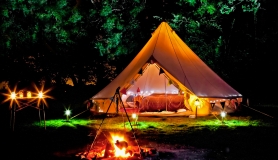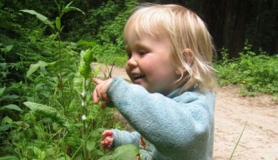The game “what’s in the bag?” provides endless opportunities for warm, sensitive interactions and for making stimulating discoveries with your baby. Each time your baby sees, smells, touches, hears or tastes something new, vital connections are formed in their brain. Use these ideas to help your baby explore, learn and enjoy social interactions.
Before you begin to play What’s in the Bag? follow these steps to help you get the most from this activity.
- SIT Sit in a safe comfortable space together, giving your baby as much freedom as possible to handle the object and move around. Try keeping your baby’s toes bare – babies love to explore with their feet as well as their hands.
- EXPLORE Let your baby explore with all their senses. In particular, babies love to explore with their mouths. Your baby’s gums and tongue are very sensitive and tell them a lot about how an object feels, smells and tastes. Exploring this way also strengthens the mouth muscles needed for speech.
- WATCH Try not to direct play. Your baby is naturally curious and will feel safe and secure to explore with you close by giving them your quiet attention.
- REASSURE Follow your baby’s cues. If they appear unsure, give a smile or encouraging word. If your baby holds out an object, or drops it and looks for your reaction, take it, saying thank you. You could have a similar object to explore alongside your baby.
- STOP Don’t worry if your baby isn’t interested. Stay tuned in to your baby’s feelings and try returning to the activity later.
TIME TO PLAY
Early play, with gentle encouragement and reassurance from you, nurtures curiosity, confidence and self-esteem. It even helps your baby begin to manage their emotions. The chance to explore everyday objects gives your baby the skills needed to gain independence.
Physical
BIG AND SMALL MOVEMENTS - Physically exploring objects strengthens muscles and helps your baby discover how to control and co-ordinate their body. Your baby gains control of the larger, “gross motor” movements of the head, body and limbs first, then learns to control the smaller “fine motor” movements of their hands, feet and fingers. Mastering these skills and learning how to balance and adjust their position leads to crawling, walking, running and jumping.
HAND-EYE COORDINATION - Newborns have a grasp reflex, whereby they automatically grip objects placed in the hands. When this fades, they learn to pick up objects at will. First, a baby follows an object with their eyes. To reach out, curl their hands around it and pick it up, they need to be able to control and coordinate their movement with what they see. This is known as hand-eye coordination. Handling objects refines their fine motor skills. As their coordination improves, they will form a pincer grip between their thumb and fingers, which is essential for skills like tooth brushing or catching a ball.
CROSSING THE MIDLINE - When babies follow a moving object across their field of vision or reach across with the right hand to something on the left side, they cross the midline – an imaginary line down your baby’s middle separating the right and left sides of the body. Crossing this line coordinates both sides of the brain, which helps your baby to use opposite sides of the body at the same time, aiding skills such as crawling, and eventually helping to coordinate eye movements to follow words across a page.
Awareness
SPACE AND DISTANCE - Playing with everyday objects helps your baby to develop spatial awareness – a sense of where their body is in space and in relation to objects around them. When reaching for an object, your baby also has to judge distance and think about how far to move to reach their goal – a skill needed for maths later on.
BODY AWARENESS - As coordination and movements are refined, your baby develops something known as proprioception – the sense of knowing where different parts of the body are – which enables your baby to carry out actions, such as picking up a cup and drinking from it, without needing to stop, look and think.
RIGHT OR LEFT? - As your baby explores objects, they may use either hand before developing a preference for one hand or the other.
Understanding
OBJECT PERMANENCE - Playing peekaboo with objects such as scarves, or putting an object in the bag and taking it out again, teachers your baby that when people or objects are hidden, they are still there. This understanding, known as object permanence, usually develops in the first year. You’ll recognise this developmental stage when they look for a covered up object or one that has rolled away.
MANAGING EMOTIONS - Playing with objects helps your baby to persevere and build resilience, for example, by having another go at building up blocks. Your baby learns about reactions and emotions from observing your face, tone of voice and gestures.
CAUSE AND EFFECT - During exploration, your baby sees how actions have consequences – cause and effect – so a shaker makes a noise when it’s moved, or a cup empties if tipped.
Maths
EARLY MATHS - Maths is about so much more than numbers and counting. It is through investigating objects that your baby begins to understand ideas such as size, shape, weight, volume and quantity. Your baby also starts to discover the various properties of objects, for example, a ball will roll away but a sock won’t.
FIRST SEQUENCES - Playing “What’s in the bag?” regularly helps your baby to anticipate what is coming next. As well as being fun, this also means your baby starts to recognise the sequence of events and develop a sense of order, a basic concept that forms the foundation for learning about numbers and counting.
Drawing and writing
FIRST MARKS - Investigating objects and encouraging messy play, for example splodging paint on paper, gives your baby lots of opportunities to start making their first marks. As your baby engages in spontaneous mark making, they gradually acquire the strength, fine motor skills and coordination needed to hold and direct a crayon or pencil.
LEARNING ABOUT MEANING - When you recognise and value these early marks you help your baby understand that their actions created the marks and, eventually, that their marks have a meaning. Although it will be a while before your baby forms real letters or connect sounds with words, these early marks of the first steps towards the process of drawing and writing.
Communication
BODY LANGUAGE - Body language is your baby’s very first language. As you watch your baby play, notice how they use their eyes to show interest in something, glancing between you and the object in a meaningful way. You can show your mutual interest by following the direction of your babies gaze.
BUILDING VOCABULARY - Naming and describing objects helps your baby to form an image of it in their mind and to link the word to the object. Your baby is developing their memory and building up a bank of words. You will see this recognition in action when your baby starts to use objects in appropriate ways during play, such as trying to put a sock on their foot. Research has found that immersing babies and young children in language, even ideas and words that are beyond their understanding, helps to develop a wide vocabulary, which is linked to complex thinking and is the foundation for doing well in every subject at school.
FIRST SOUNDS - Babies often babble contentedly to themselves while they are playing, exercising their mouth muscles as they practice the sounds needed for speech development. Your baby might also want to “talk” to you. You can have a wonderful chat without using real words at all. When your baby looks at you with an inviting twinkle in their eye and a tentative sound, repeat the sound then leave a gap for their response. This simple interaction helps your baby understand the turn-taking patterns in real conversations.
POSITIVE INTERACTIONS - You may find that your baby is particularly responsive if you speak in the gentle sing-song voice known as “parentese”. These first conversations teach your baby about socialising and help them to develop the social skills they will need later on. Your baby will break eye contact and turn away when they need a rest so watch out for this cue.
HOW TO PLAY
Each time you open the bag…
- ANTICIPATE - Express interest about what’s in the bag and convey the sense of excitement to help your baby anticipate what is coming next.
- EXPLORE - Encourage your baby to feel the object inside the bag before opening it. Try to guess the shapes and sizes to help your baby think about these different properties.
- LISTEN - Before opening the bag together, help your baby investigate whether the object makes a sound. Does it rustle, rattle or jingle?
- DISCOVER - Help your baby to open the bag and discover what’s inside. Your baby is learning how curiosity and investigation can lead to the reward of discovery.
MORE INSPIRATION
READ Play and Learn with your Baby Forward by Nigel Clarke £14.99 DK







